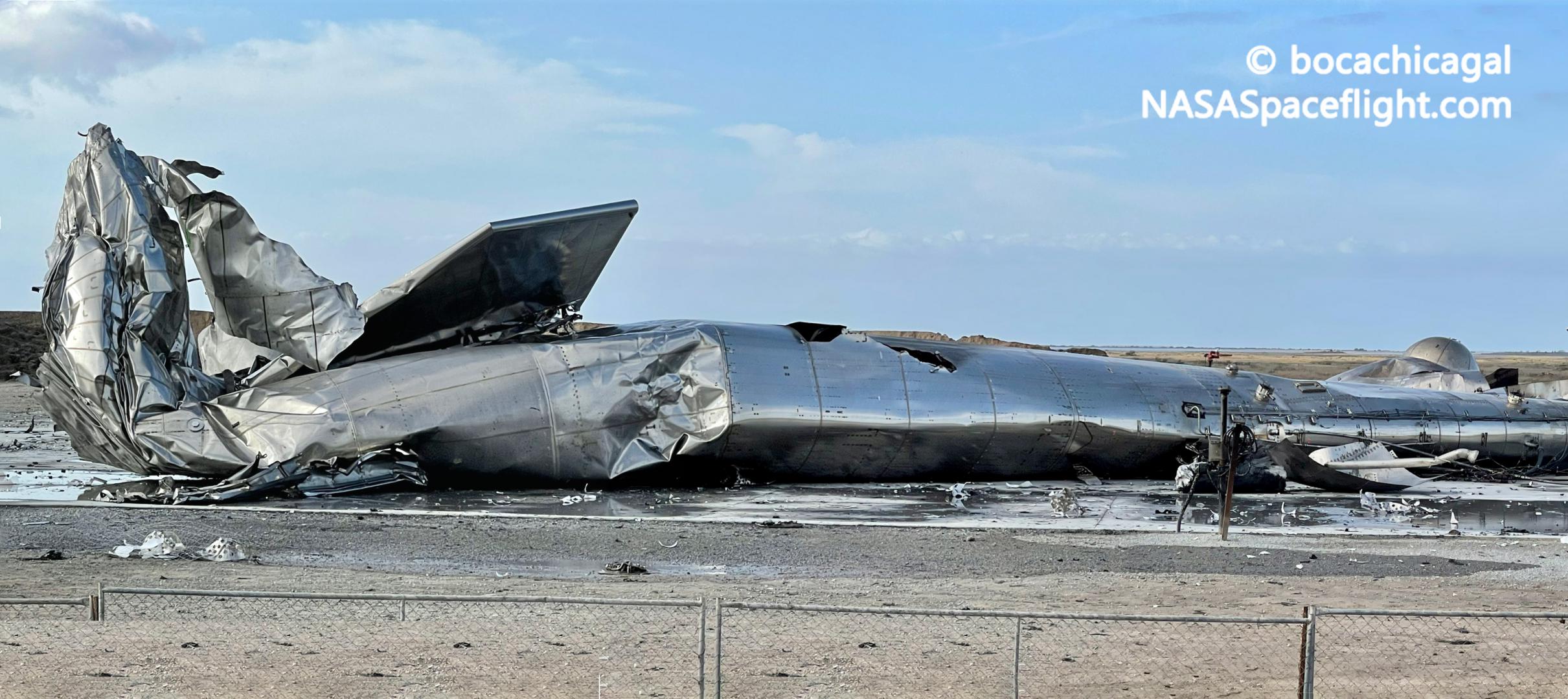

News
SpaceX already clearing Starship debris, preparing for next rocket rollout
Update: Half a day after Starship serial number 10 (SN10) became the first prototype to land in one piece, SpaceX has begun clearing its remains and preparing to roll the next rocket to the launch pad.
Never one to rest on its laurels, SpaceX appears to be wasting no time moving forward from Starship SN10’s successful landing and subsequent explosion. Almost a month ago, SpaceX stacked SN10’s successor – Starship SN11 – to its full height and has spent the last four weeks closing out the virtually identical rocket. As of SN10’s launch debut, Starship SN11 has been more or less finished and ready to roll to the launch pad for at least a week.
At the same time as SpaceX teams have begun the process of recovering SN10’s remains, the company also transported a large crane to the launch site – the same crane used to install Starships SN8, SN9, and SN10 at the launch pad. Stay tuned for updates as SpaceX prepares SN11 for a fourth high-altitude launch and landing attempt – this time with the goal of keeping the rocket intact after landing.
In a classically spectacular fashion, a SpaceX Starship prototype has successfully touched down in one piece for the first time ever, only to explode minutes later after catching itself on fire.
Rolled from SpaceX Boca Chica Starship factory to test and launch facilities just a mile down the road on January 28th, Starship SN10 lifted off just five weeks later – the fastest factory-to-launch flow yet. The speed of that turnaround was mainly made possible thanks to an exceptionally smooth test campaign, passing cryogenic proof and static fire tests after only a few attempts.
Prior to its second launch attempt, Starship SN10 automatically aborted a few seconds prior to its first attempt after the rocket’s flight computer determined that its three Raptor engines were producing more thrust than expected. Within half an hour of the abort, CEO Elon Musk took to Twitter to reveal the cause and stated that SpaceX would be tweaking the flight software’s thrust limits and recycling for another shot at launch around two hours later.
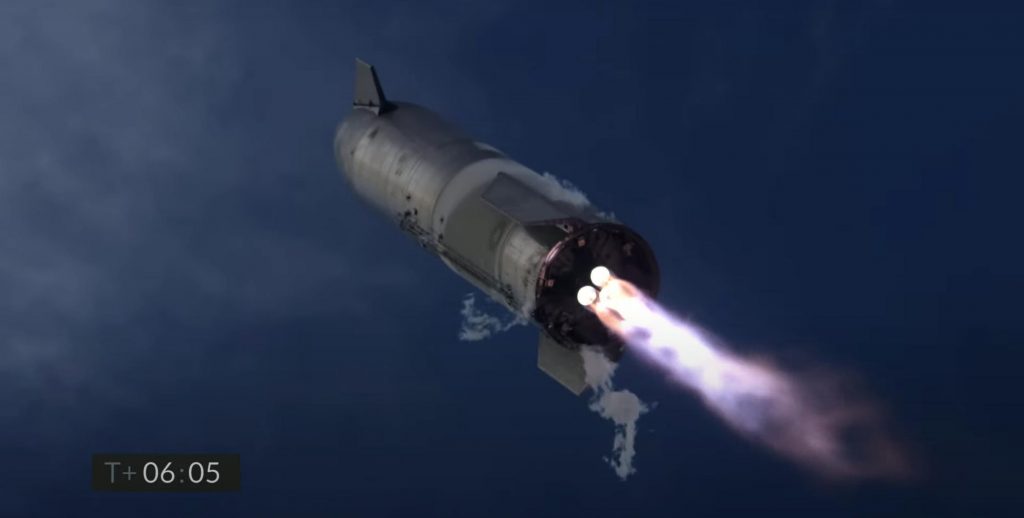
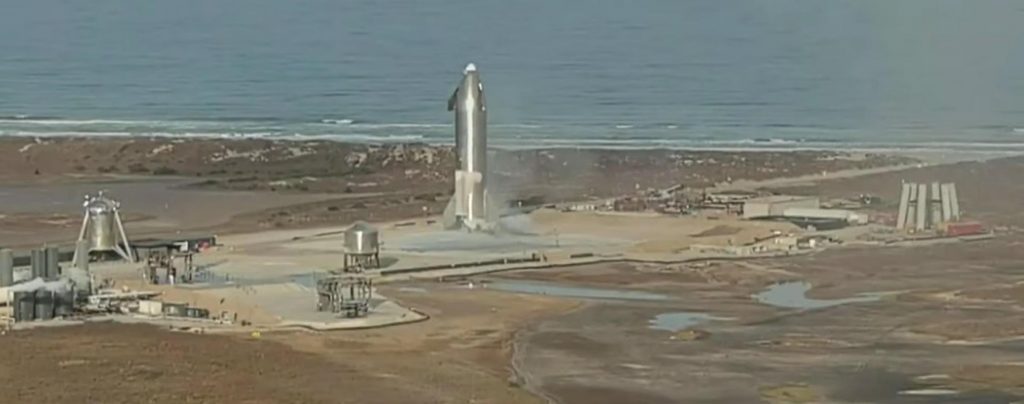
Up to the last 20 or so seconds of the 6.5-minute flight test, Starship SN10’s launch debut was virtually identical to Starships SN8 and SN9, both of which made it just one or two dozen seconds away from a soft landing. However, after SN9, SpaceX optimized the landing process to add additional redundancy, meaning that SN10 reignited all three of its Raptor engines – instead of just two – for its flip and landing burn.
Exactly as planned, SN10 fired up those engines, autonomously analyzed their performance, and then shut down two Raptors to leave the best-behaving engine to complete the final landing burn. Unlike SN8 and SN9, that maneuver went about as well as it could have, nearly slowing SN10 to a hover with one (seemingly) healthy engine to take it the rest of the way to the ground.
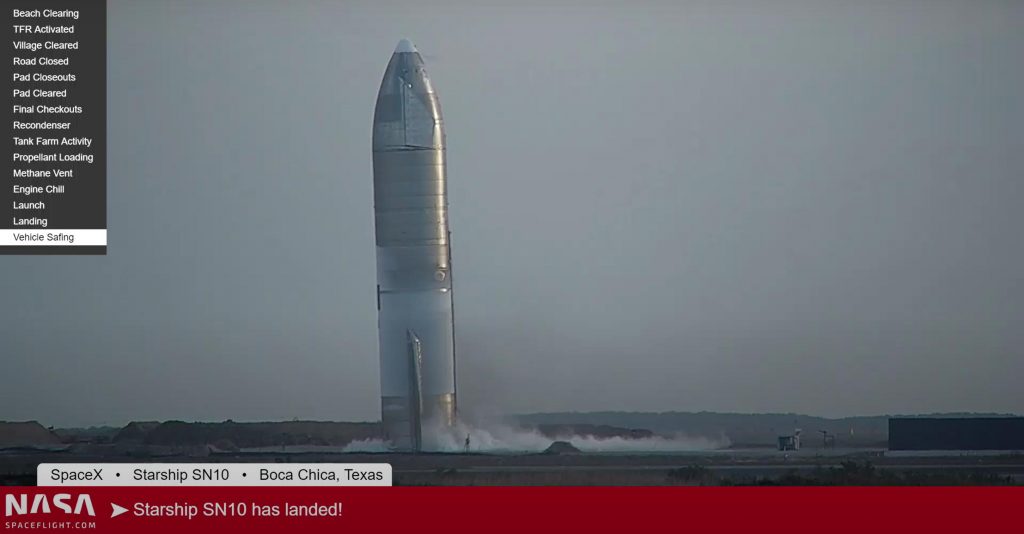
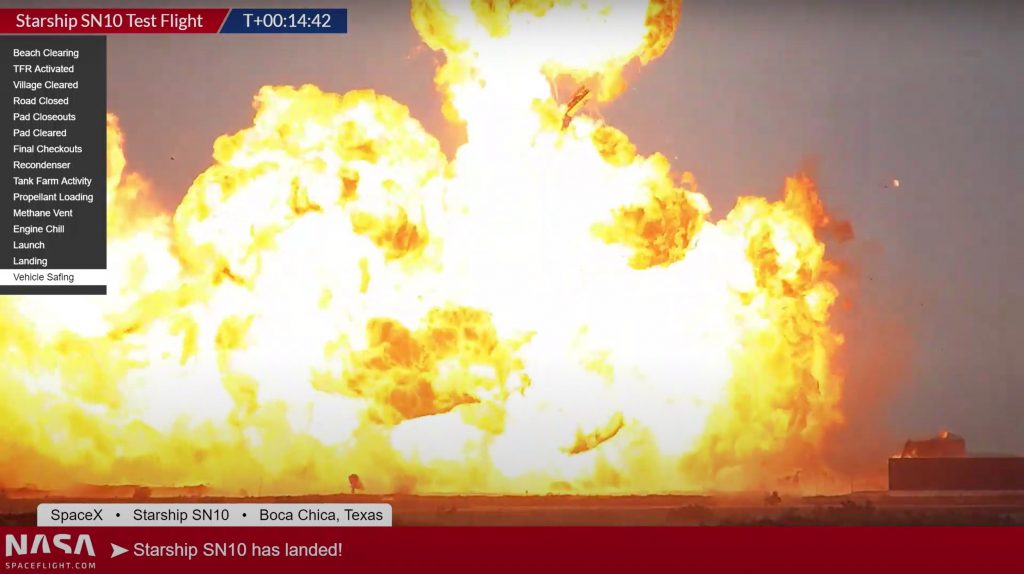
After all that heroic effort and for the first time ever, Starship SN10 proceeded to touch down in one piece. Through the eyes of a drone hovering far away from the launch complex, the landing couldn’t exactly be considered ‘soft,’ however, and SN10 impacted the landing zone with some substantial momentum – likely far too much for its tiny legs to handle.
However, more importantly, SN10 appeared to ignite one or two of its own gaseous oxygen or methane vents, triggering a fire that remained visible until well after the hard – but intact – landing. From official and unofficial views of the landed vehicle, Starship SN10 had a significant lean and appeared to have no more than a few inches to a foot of clearance between its aft skirt and the concrete pad. Remote-controlled firefighting spigots were able to extinguish any external sign of fire but that lack of clearance may have prevented the water from doing much inside the skirt, ultimately dooming Starship SN10.
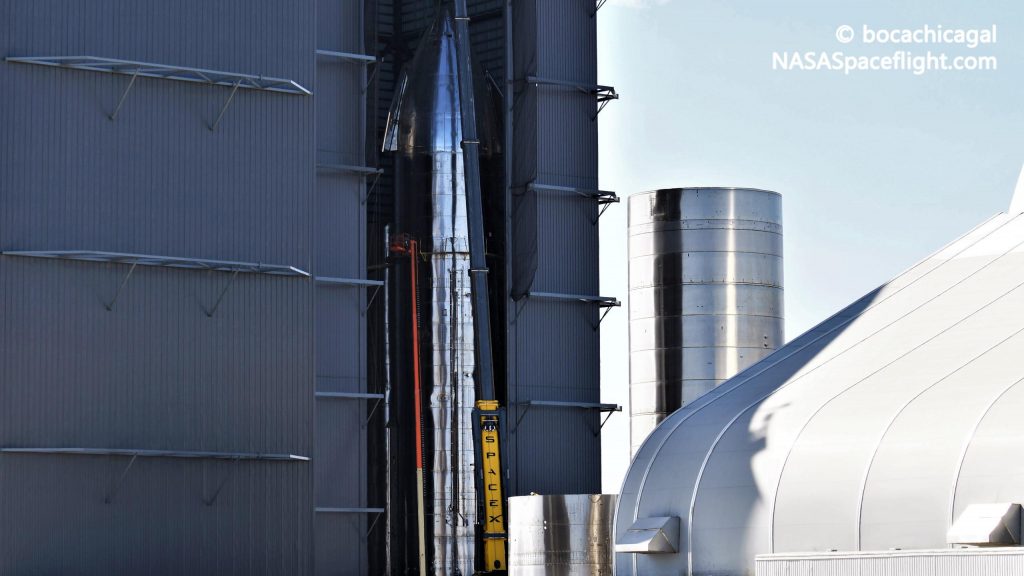
Regardless of where exactly that fire ‘broke through,’ so to speak, the original cause of the fire – accidentally igniting a vent plume – is unlikely to be a hard problem to fix, and it’s safe to say that SN10’s intact landing is an extraordinary success for SpaceX. In its official webcast, SpaceX engineer John Insprucker confirmed that Starship SN11 is all but complete and could roll out to the launch pad to pick up where SN10 left off almost as soon as it’s safe to do so.

Elon Musk
Elon Musk and James Cameron find middle ground in space and AI despite political differences
Musk responded with some positive words for the director on X.

Avatar director James Cameron has stated that he can still agree with Elon Musk on space exploration and AI safety despite their stark political differences.
In an interview with Puck’s The Town podcast, the liberal director praised Musk’s SpaceX achievements and said higher priorities must unite them, such as space travel and artificial intelligence. Musk responded with some positive words for the director on X.
A longtime mutual respect
Cameron and Musk have bonded over technology for years. As far back as 2011, Cameron told NBC News that “Elon is making very strong strides. I think he’s the likeliest person to step into the shoes of the shuttle program and actually provide human access to low Earth orbit. So… go, Elon.” Cameron was right, as SpaceX would go on to become the dominant force in spaceflight over the years.
Even after Musk’s embrace of conservative politics and his roles as senior advisor and former DOGE head, Cameron refused to cancel his relationship with the CEO. “I can separate a person and their politics from the things that they want to accomplish if they’re aligned with what I think are good goals,” Cameron said. Musk appreciated the director’s comments, stating that “Jim understands physics, which is rare in Hollywood.”
Shared AI warnings
Both men have stated that artificial intelligence could be an existential threat to humanity, though Musk has noted that Tesla’s products such as Optimus could usher in an era of sustainable abundance. Musk recently predicted that money and jobs could become irrelevant with advancing AI, while Cameron warned of a deeper crisis, as noted in a Fox News report.
“Because the overall risk of AI in general… is that we lose purpose as people. We lose jobs. We lose a sense of, ‘Well, what are we here for?’” Cameron said. “We are these flawed biological machines, and a computer can be theoretically more precise, more correct, faster, all of those things. And that’s going to be a threshold existential issue.”
He concluded: “I just think it’s important for us as a human civilization to prioritize. We’ve got to make this Earth our spaceship. That’s really what we need to be thinking.”
News
Blue Origin announces Super-Heavy New Glenn 9×4 to Rival SpaceX Starship
The announcement followed the company’s successful NG-2 launch on November 13.

Blue Origin has revealed plans to develop New Glenn 9×4, a “super heavy” rocket designed to deliver 70 metric tons to low-Earth orbit and directly compete with SpaceX’s Starship.
The announcement followed the company’s successful NG-2 launch on November 13, which deployed NASA’s ESCAPADE (Escape and Plasma Acceleration Dynamics Explorers) Mars mission and landed the first stage.
Upgraded engines and reusability
As noted in a Universe Today report, Blue Origin will roll out upgraded BE-4 engines producing 640,000 lbf each, up from 550,000 lbf, starting with NG-3. This should boost the New Glenn rocket’s total first-stage thrust to 4.5 million pounds. Upper-stage BE-3U engines are expected to improve from 320,000 lbf to 400,000 lbf over the next few flights as well.
“These enhancements will immediately benefit customers already manifested on New Glenn to fly to destinations including low-Earth orbit, the Moon, and beyond. Additional vehicle upgrades include a reusable fairing to support increased flight rates, an updated lower-cost tank design, and a higher-performing and reusable thermal protection system to improve turnaround time,” Blue Origin noted.
New Glenn “Super Heavy” 9×4
The super-heavy New Glenn 9×4, with nine BE-4s on the booster, four BE-3Us on the upper stage, will feature an 8.7-meter payload fairing. Blue Origin expects New Glenn 9×4 to be capable of transporting 70 metric tons to LEO, 14 tons to GSO, and 20 tons to trans-lunar injection, as noted by the company in a blog post. This is very impressive, as New Glenn 9×4’s capacity exceeds Falcon Heavy, SpaceX’s largest rocket available to consumers today. Falcon Heavy is capable of carrying up to 64 metric tons to low Earth orbit in a fully expendable configuration.
That being said, SpaceX’s Starship’s capacity is extremely impressive. As per SpaceX, Starship is designed to be capable of carrying up to 100-150 metric tonnes to orbit in its fully reusable configuration. At its expendable configuration, Starship’s capacity enters unheard-of territory, with SpaceX stating that the vehicle could transport 250 metric tonnes of cargo.
News
Tesla FSD approved for testing in Nacka, Sweden, though municipality note reveals aggravating detail
Nacka, Sweden, a municipality just a few miles from Stockholm, has given its approval for FSD tests.
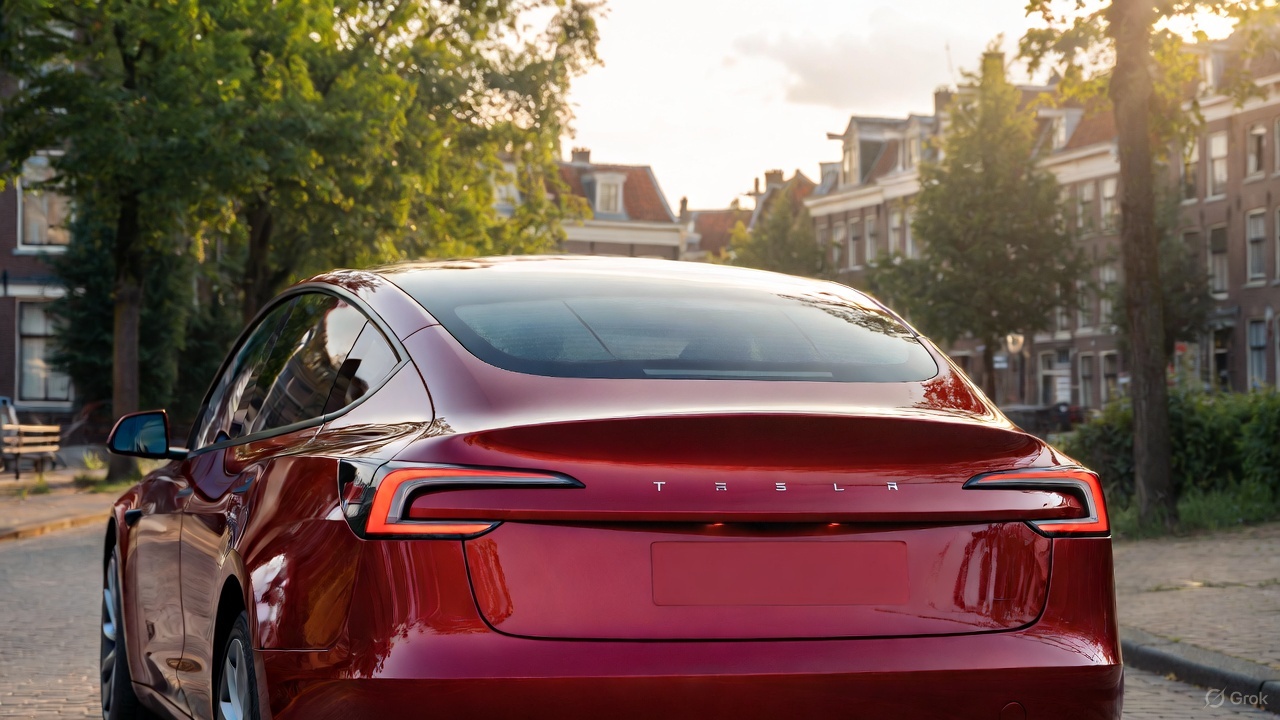
Tesla has secured approval for FSD testing in an urban environment in Sweden. As per recent reports from the Tesla community, Nacka, Sweden, a municipality just a few miles from Stockholm, has given its approval for FSD tests.
A look at the municipality’s note regarding FSD’s approval, however, reveals something quite aggravating.
FSD testing approval secured
As per Tesla watcher and longtime shareholder Alexander Kristensen, Nacka is governed by the Moderate Party. The shareholder also shared the municipality’s protocol notes regarding approval for FSD’s tests.
“It is good that Nacka can be a place for test-driving self-driving cars. This is future technology that can both facilitate mobility and make transportation cheaper and more environmentally friendly,” the note read.
The update was received positively by the Tesla community on social media, as it suggests that the electric vehicle maker is making some legitimate headway in releasing FSD into the region. Sweden has been particularly challenging as well, so securing approval in Nacka is a notable milestone for the company’s efforts.
Aggravating details
A look at the notes from Nacka shows that FSD’s proposed tests still met some opposition from some officials. But while some critics might typically point to safety issues as their reasons for rejecting FSD, those who opposed the system in Nacka openly cited Tesla’s conflict with trade union IF Metall in their arguments. Fortunately, Nacka officials ultimately decided in Tesla’s favor as the company’s issues with the country’s unions are a completely different matter.
“The left-wing opposition (S, Nackalistan, MP and V) voted no to this, referring to the fact that the applicant company Tesla is involved in a labor market conflict and does not want to sign a collective agreement. We believe that this is not an acceptable reason for the municipality to use its authority to interfere in a labor law conflict.
“Signing a collective agreement is not an obligation, and the company has not committed any crime. The municipality should contribute to technological development and progress, not work against the future,” the note read.









